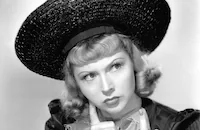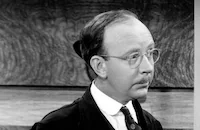Rose of Washington Square

Brief Synopsis
Cast & Crew
Gregory Ratoff
Tyrone Power
Alice Faye
Al Jolson
William Frawley
Joyce Compton
Film Details
Technical Specs

Synopsis
Vaudeville singer Ted Cotter meets Rose Sargent when he is singing at the Irving Palace burlesque house and she is performing in an amateur competition at a nearby theater. Ted falls in love with Rose, and when he ascends to stardom, he becomes her patron, helping her to rise from the music hall to the Broadway stage. Rose clicks in the Ziegfeld Follies and soon becomes a star herself, while Ted continues to worship her in silent devotion. Rose does not return Ted's feelings, however, and instead falls in love with the handsome con artist and gambler, Bart Clinton. Blinded by her love, Rose fails to see Ted's devotion and Bart's worthlessness. Rose marries Bart, whose lust for easy money drives him to break the law and leads to his arrest by the police. Ted puts up the $50,000 bail bond for Bart, but the scoundrel skips out on bail and disappears. Throughout all her trials, Rose sticks by her man, pouring her love and faith into the song "My Man," which she sobs out every night from the stage. One night, Bart is drawn to see his wife perform, and her rendition of "My Man" forces him to realize that he must give himself up to the police. This act of honesty, which has been motivated by love, redeems Bart, and Rose promises to wait for him while he serves his prison sentence.

Director

Gregory Ratoff
Cast

Tyrone Power

Alice Faye

Al Jolson

William Frawley

Joyce Compton

Hobart Cavanaugh

Moroni Olsen

E. E. Clive
Louis Prima
Charles Wilson
Hal K. Dawson
Paul Burns
Ben Welden
Horace Macmahon
Paul Stanton
Maurice Cass
Harry Hayden

Charles Lane
Adrian Morris

John Hamilton
Winifred Harris
Bert Roach
Irma Wilson
Robert Shaw
Crew
Richard Day
Seymour Felix
Karl Freund
Mack Gordon
Eugene Grossman
James F. Hanley
Roger Heman
Jerry Horwin
Nunnally Johnson
Nunnally Johnson
John Larkin
Thomas Little
Louis Loeffler
Ballard Macdonald
Booth Mccracken
Harry Revel
Royer
Louis Silvers
Rudolph Sternad
Darryl F. Zanuck

Film Details
Technical Specs

Articles
Rose of Washington Square
Faye plays Rose Sargent, a struggling vaudevillian in post-World War I New York who falls in love with handsome but shady Bart Clinton (Power). Her pal and former vaudeville partner Ted Cotter (Al Jolson), who has become a star on his own, helps her become a star as well. Even though the protective Ted distrusts Bartís wheeling and dealing, Rose marries Bart. Eventually, Bartís financial misdeeds catch up with him, and he goes on the lam, while Rose sings about her heartbreak in another tune identified with Brice, ìMy Man.î Brice first sang it in the Ziegfeld Follies in 1921, after Arnstein had been accused of bond theft but had not yet surrendered to authorities.
Rose of Washington Square begins with the usual disclaimer, that it is ìentirely fictional and any similarity with actual persons either living or dead is not intentional but coincidental.î It was too coincidental for Brice. She sued Fox and the three stars for defamation of character, unauthorized use of her life story, and invasion of privacy. The studio settled out of court, for an undisclosed sum, believed to be $30,000 to $40,000. Arnstein filed his own suit, and settled for $25,000. Like the fictional Rose, Brice stood by her man, paying his legal bills as his case wound through the courts, and waiting for him as he served a 14-month sentence in Leavenworth. She finally divorced him in 1927, after he cheated on her with an older, richer woman.
When she made Rose of Washington Square, Faye was singing the blues over marital problems of her own. Married to singer Tony Martin since 1937, she was a bigger star than he was. His film career had failed to take off, so he concentrated on his singing career and was often on the road. Faye couldnít go with him, because she was too busy working in one movie after another. They divorced in 1940, and each remarried happily, Faye to bandleader Phil Harris, and Martin to dancer Cyd Charisse.
Al Jolson hoped that Rose of Washington Square would be a career comeback for him. A vaudeville and theatrical giant since 1911, Jolson made film history when he starred in The Jazz Singer (1927), the first film with synchronized dialogue. By the mid-1930s, his Broadway career, which he had abandoned for movies, was over. His films were no longer successful, and his contract with Warner Bros. had ended. Jolson hadnít made a picture in three years when he got the Fox offer for a supporting role with third billing in Rose of Washington Square. In the film, Jolson reprised all his biggest hits, including the blackface ìMammy,î ìToot-Toot-Tootsie,î ìRockabye Your Baby,î and California Here I Come,î and got the best reviews. Frank Nugent wrote in the New York Times, ìMr. Jolsonís singingÖis something for the memory bookÖ[Screenwriter Nunnally] Johnson would have been wiser, we believe, to have built his tale about Mr. Jolsonís career. The picture was at its best when the Mammy specialist held the spotlight.î
Jolson acted in only one more film, but his career got a boost in the mid-1940s when Columbia made a somewhat fictionalized biopic, The Jolson Story (1946). Larry Parks played Jolson, but Jolson himself sang all the songs. It was so popular that there was a sequel, Jolson Sings Again (1949).
For todayís audiences, however, Fayeís singing in Rose of Washington Square may be less dated than Jolsonís. Her version of Briceís trademark, ìMy Man,î (sung leaning on a lamppost as Brice did) is very different from Briceís, but just as effective. And Faye knew how to swing, as she proves in a lively version of ìIím Just Wild About Harry,î with great riffs by trumpeter and bandleader Louis Prima. Jolson could be something of an ego monster, and Faye later recalled him as ìan obnoxious boor,î and ìthe most awful man I ever met. Every time I go past that cemetery out in L.A. I look at that big tombstone and wonder how it ever keeps him down.î
Fanny Brice was just as blunt. She and Jolson had worked together onstage, touring in the Shubert Brothers show The Whirl of Society in 1912, when Jolson was already a star, and Briceís career was still rising. She first met Arnstein in Baltimore during that tour. When Jolson died in 1950, a reporter called Brice for a reaction. The always-frank Brice responded, ìI never liked him.î
Fanny Brice died in 1951. In 1964, producer Ray Stark, who was married to Brice and Arnsteinís daughter Frances, presented the Broadway musical, Funny Girl, starring Barbra Streisand as Fanny Brice. Like Rose of Washington Square, it was a highly-romanticized version of the Brice-Arnstein relationship. Funny Girl was a big hit, made Streisand a star, and was made into a 1968 film which won Streisand an OscarÆ.
Director: Gregory Ratoff
Screenplay: Nunnally Johnson, story by John Larkin
Cinematography: Karl Freund
Editor: Louis R. Loeffler
Costume Design: Royer
Art Direction: Richard Day, Rudolph Sternad
Music: Mack Gordon, James F. Hanley, Ballard MacDonald, Harry Revel
Principal Cast: Tyrone Power (Bart Clinton), Alice Faye (Rose Sargent), Al Jolson (Ted Cotter), William Frawley (Harry Long), Joyce Compton (Peggy), Hobart Cavanaugh (Whitey Boone), Moroni Olsen (Buck Russell), E.E. Clive (Barouche Driver), Louis Prima (Bandleader)
by Margarita Landazuri

Rose of Washington Square
Quotes
Trivia
The film so closely resembled the life of entertainer Fanny Brice that Miss Brice sued 20th Century Fox for invasion of privacy and won.
Notes
The working titles of this film were I Love That Man and Bowery Nightingale. It was based on the unpublished original story "I Love That Man" by Jerry Horwin and John Larkin, that was inspired by the life of the Ziegfeld Follies star Fanny Brice. According to a news item in Hollywood Reporter, Roy Del Ruth was originally slated to direct the picture but quit over differences with studio officials. Materials contained in Twentieth Century-Fox Produced Scripts Collection at the UCLA Theater Arts Library disclose that the studio had originally intended to star Eddie Cantor in the film. Story conferences with Darryl F. Zanuck add that Sid Silvers was to have written a "stooge" routine for the script and Jule Styne was to have worked with Mack Gordon and Harry Revel on vocal arrangements. The participation of Stein and Silver in the final film has not been confirmed. According to a news item in Hollywood Reporter, Joyce Compton replaced Marie Wilson in the role of "Peggy" when Wilson became ill after four days of shooting. Other news items in Hollywood Reporter note that the picture was to feature twenty-two songs and that vaudeville performers The Biltmorettes, Maxwell Turk, Lurline Uller, Igor and Tanya, The Sophisticates, Marvin Jensen, and Stanley and White were signed to appear in the Greenwich Village number. A $75,000 set of Madison Square Gardens was erected at Fox's Western Ave. studios for this picture. The studio also used new, lightweight cameras in filming this picture.
According to other news items in Hollywood Reporter, Nicky Arnstein, who was Fanny Brice's husband, asked the Superior Court to prevent Fox from showing this picture because it was embarassing to him. The studio paid Arnstein $25,000 to settle the suit. Other films based on the life of Fanny Brice were the 1968 Columbia film Funny Girl, starring Barbra Streisand and Omar Shariff and directed by William Wyler; and its 1975 Columbia sequel Funny Lady, also starring Streisand and Shariff and directed by Herbert Ross.















